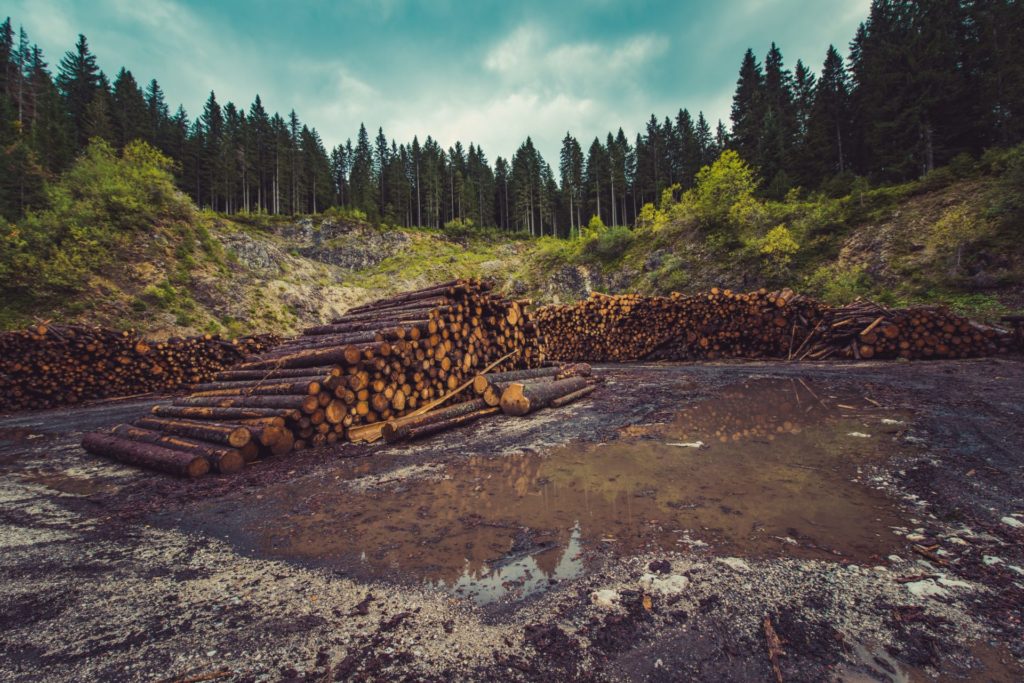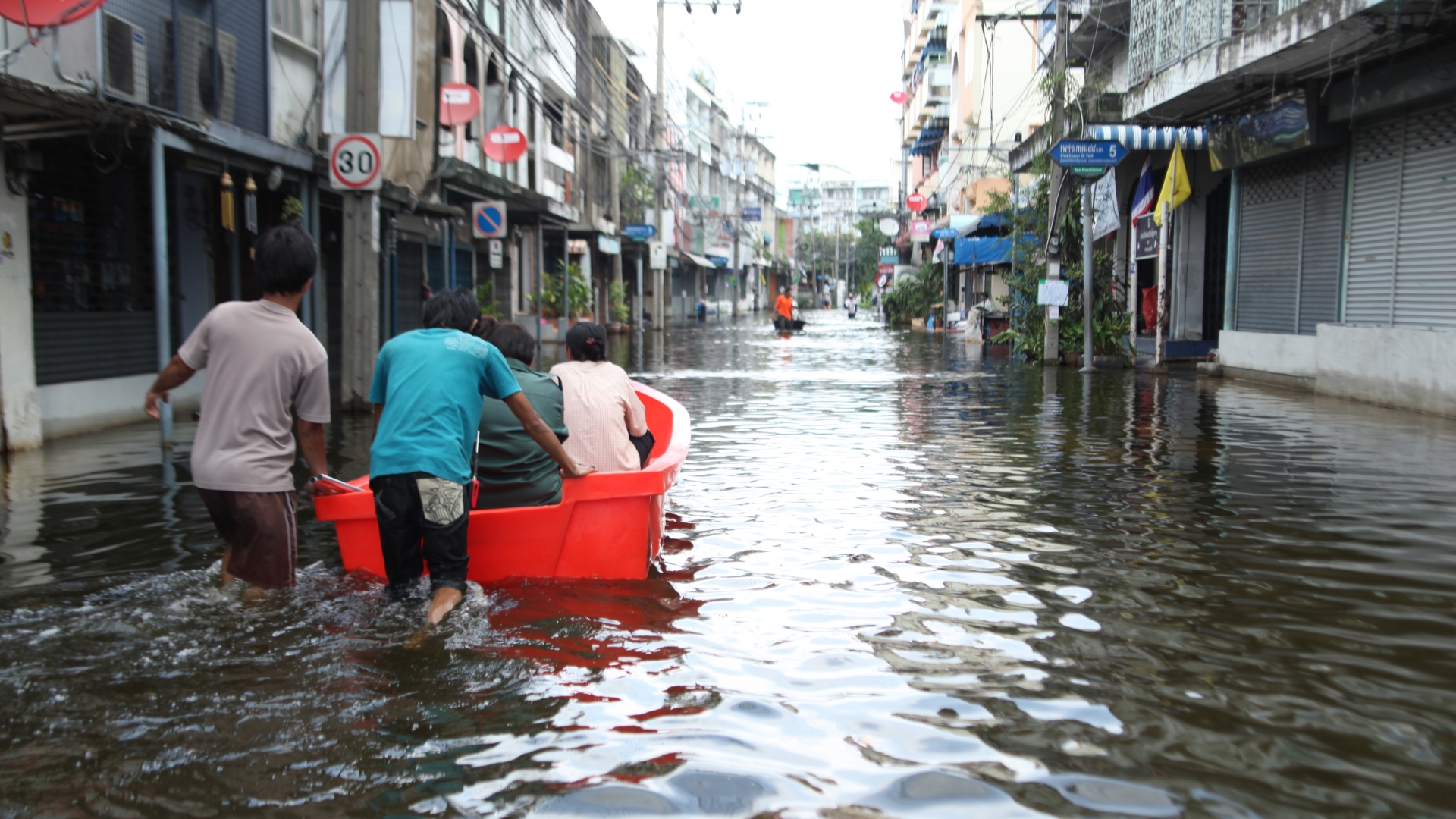The More Populous We Become, the More Humans Affect the Environment
Written and edited by Hannah Evans, Senior Analyst, Population Connection, and Janet Larsen, Principal, One Planet Strategies LLC
Photo above: Deforestation in the Pacific Northwest. Ales Krivec, Unsplash
Earth’s complex natural systems sustain all life. Biodiverse terrestrial, freshwater, and marine ecosystems also support human livelihoods and well-being.
When human numbers were small, our impact on the environment was local. However, as the global population has expanded and technologies have evolved, pressure on nature has increased. Growing populations have converted forests and wetlands into farms and settlements. Human activities are driving large scale changes in terrestrial and aquatic environments through pollution, water withdrawals, the hunting and harvesting of organisms, and the movement of invasive species around the globe [1]. The sustained overuse of natural resources has caused unprecedented levels of environmental destruction, including the loss of ecosystems and biodiversity [2].
One overarching result of human overreach is climate change. Greenhouse gases emitted from land use, industry, and the escalating use of fossil fuels are elevating Earth’s temperature faster than at any point since the dawn of civilization [3]. This warming is altering Earth’s capacity to supply food and fresh water and to sustain human health and well-being [4]. Climate impacts such as weather extremes and wildfires are hitting harder and sooner than scientists anticipated even 10 years ago [4].
While the global population is projected to grow substantially over coming decades, ecosystem degradation and climate change threaten human prospects. Limiting the impacts requires shrinking humanity’s environmental footprint with a global shift toward renewable energy sources, sustainable land use practices, and responsible consumption patterns. Underlying this shift is the need to account for human populations responsibly by ensuring that family planning information and services are available to all who desire them.

Humanity’s Environmental Footprint
While it is impossible to put a price tag on a healthy planet, economists calculate that the value of the services provided each year by well-functioning terrestrial ecosystems is at least equivalent to the annual global gross domestic product (GDP) [5]. Thriving ecosystems produce oxygen, purify water, protect from storms, provide food, and regulate the climate.
Yet humanity has an extensive history of using Earth’s life-sustaining natural resources unsustainably. The aggregate human demands on resources have exceeded the Earth’s regenerative capacity since the 1970s. The Global Footprint Network notes that “more than 80% of the world’s population lives in countries that are running ecological deficits, using more resources than what their ecosystems can regenerate,” by “overfishing, over-harvesting forests, and emitting more carbon dioxide into the atmosphere than forests can sequester” [6]. The organization tallies that it takes a year for Earth to rebuild the resources people use in just seven months [7].
A Changing Climate
For most of human history, people had little effect on the global climate. The dawn of the industrial era signaled a turning point. Starting around 1750, growing and industrializing populations ramped up the burning of fossil fuels, emitting heat-trapping greenhouse gases such as carbon dioxide (CO2) and methane into the atmosphere. Over the decades, the use of fossil fuels has increased, first with coal, then oil, and then natural gas. Meanwhile, the clearing of forests and other natural ecosystems for farming and development has released additional greenhouse gases while reducing nature’s capacity for carbon absorption [8].
Since the Industrial Revolution, humans have released enough greenhouse gases into the atmosphere to raise the average global temperature by 1.1°C (close to 2°F) [8]. Warming has increased more rapidly since the 1970s than at any point in modern history [8]. At the same time, the global population has more than doubled [9]. The effects of this warming vary by region and include longer wildfire seasons, melting glaciers and ice caps, and more extreme weather such as heatwaves, more powerful storms, and flooding. Climate scientists warn that global temperature increases of 1.5°C and beyond will have far more devastating effects, from more destructive storms and prolonged droughts to inundation of coastal areas from mounting sea-level rise [10]. The impacts are magnified with each additional degree of warming [8].
Governments around the world are working to avoid dangerous climate change. Nearly every country is party to the Paris Agreement Under the United Nations Framework Convention on Climate Change, which aims to hold the global temperature rise “to well below 2°C above pre-industrial levels and pursu[e] efforts to limit the temperature increase to 1.5°C above pre-industrial levels, recognizing that this would significantly reduce the risks and impacts of climate change” [11].
At recent emissions rates, the Intergovernmental Panel on Climate Change (IPCC) estimates that warming could reach 1.5°C (2.7°F) between 2030 and 2052 (see Figure 1) [10]. Climate scientists maintain that keeping warming from exceeding that level would require global greenhouse gas emissions to decrease by 8.7% each year between 2024 and 2030 [12]. Even keeping warming to 2°C would require emissions cuts of 5.3% each year [12]. Yet while some progress is being made to achieve national goals, global emissions have continued to rise [13].
The risks from climate change are multiplying. These changes will impact the world’s population in many ways, but specifically in terms of the capacity to use and manage land, adapt to extreme weather events, produce food, and access fresh water [14]. Delaying action will only increase costs and leave more people vulnerable.
Figure 1
Growing Populations and Increasing Greenhouse Gas Emissions
Economic growth and population growth drive climate change, with economic growth taking on outsized importance since the turn of the 21st century [15]. From a historical perspective, early industrializing countries, specifically the United States, Russia, Germany, the United Kingdom, and Japan, have added the most CO2 into the atmosphere [16]. In recent decades the world’s two most populous countries, China and India, have joined this group of top carbon emitters (see Figure 2) [17]. Currently, 10 countries account for over two-thirds of the world’s annual industrial and fossil fuel CO2 emissions [16]. China leads the pack, emitting more carbon than the next four countries—the United States, India, Russia, and Japan—combined [16].
Carbon emissions per person are greatest in countries where energy use is high and consumption is relatively inexpensive, namely in Australia, the United States, and Canada, as well as in smaller oil and gas producing countries such as Qatar, the United Arab Emirates, Bahrain, and Kuwait [16]. Averaged across the population, each American and Australian emits close to 15 tons of CO2 each year, nearly twice as much as the average Chinese and over seven times more than the average Indian (see Figure 3) [16]. Per person emissions in the least developed countries are negligible, even as these countries are the least prepared and most vulnerable to the effects of climate change.
Figure 2
Figure 3
Industrialization facilitates economic growth and societal advances, which eventually result in improved living standards and corresponding consumption patterns. Over the last two decades, CO2 emissions have fallen in the United States and many European countries, even while economic growth has continued [16, 18, 19]. This is largely due to a reduction in reliance on coal, in part from switching to natural gas, as well as a ramp up in the use of renewable energy [20]. Many of the wealthiest countries also have, in effect, outsourced some of their emissions through trade in carbon-intense goods like steel and cement and other manufactured items [16, 21, 22].
Meanwhile, emissions are surging in emerging economies such as China, India, and Indonesia, both for domestic consumption and for the production of goods sent abroad [16, 20]. Large-scale increases in average incomes and reductions in overall levels of absolute poverty, particularly since the year 2000, have greatly increased the size of the global middle class. Future emissions trends depend on a variety of factors, including economic growth, technological change, demographic trends, and consumption rates. Because industrialization and other developmental processes typically involve the exploitation of resources to facilitate economic growth, infrastructure development, and urbanization, carbon emissions in middle-income countries, home to 75% of the world’s population, are likely to continue to rise [23].
As population growth contributes to emissions that cause global warming, it also works to compound the impacts of climate change on the individual and state levels. High fertility rates and the availability family planning information and services (or lack thereof) all play a role in climate adaptation, or a country’s institutional and ecological capacity to readily respond to and recover from climate impacts. Regions of high population growth, high fertility, and high unmet need for family planning are disproportionately vulnerable to extreme weather and disrupted food production [24]. Together, the world’s 45 least developed countries are projected to double in population between 2020 and 2060 [9]. These are the countries that have contributed the least to climate change but are poised to suffer the most from its effects.
Reliance on Fossil Fuels
The burning of oil, coal, and natural gas has facilitated economic development across the world. Oil largely is used in transportation, whereas coal and natural gas are more often used for heating and in power plants to produce electricity used in homes, businesses, and factories. Fossil fuels are also used directly in industry, such as in steel manufacturing and plastics production.
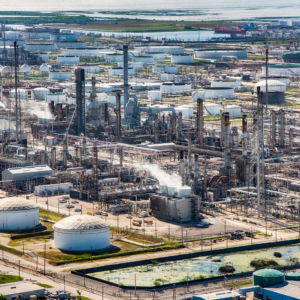
Despite record growth in renewable energy production across the globe, fossil fuels still dominate the world’s energy systems and are the primary sources of climate-changing emissions [20, 25]. Coal is the most carbon-intensive of the fossil fuels, followed by oil, and then natural gas [20]. While global oil and natural gas use have climbed respectively over the last decade by 1.1 and 1.7% annually, coal use has remained relatively flat [20]. Looking regionally, the picture changes. Coal use started to fall in Europe in 1985 and in North America about two decades later. Meanwhile, China and India have ramped up coal use. Similarly with oil, while much of the developing world is using more and more each year, consumption has been falling in Europe and North America [20].
Breaking down emissions by sector shows that the largest share of global greenhouse gas emissions comes from electricity and heat production (31%), followed by manufacturing, construction, and buildings (19%), and transportation (15%) [16]. Transportation, including cars, buses, airplanes, and ships, is fueled largely by oil [25]. Because mobility—and the ability to travel more broadly—largely reflect socioeconomic status, the per capita carbon emissions associated with transportation tend to be highest among the world’s wealthiest people. In the United States, for example, where heavy reliance on cars has encouraged sprawling development, the transportation sector generates close to 28% of the country’s greenhouse gas emissions [16].
Corporate Culpability
A small number of corporations and national government entities are driving the global climate crisis. Over 70% of the CO2 emitted into the atmosphere since the Industrial Revolution by the world’s major oil, gas, coal, and cement producers can be linked to just 78 corporate and state entities [26]. Just 57 are responsible for 80% of the fossil fuel- and cement-related CO2 emitted globally since the 2015 Paris Agreement on climate change. Despite government pledges to cut emissions, most fossil fuel companies emitted more CO2 in the seven years following that agreement than in the seven years prior (see Figure 4) [27].
This illustrates a major injustice of the climate crisis: 8 billion people are enduring climate impacts for which a small number of polluters profited. At the same time, it signals an opportunity: revamping practices of a few dozen corporations could dramatically change Earth’s temperature trajectory. Examining the contributions of this group of “Carbon Majors” to climate change raises the question of who should pay for the damages [27, 28].
Figure 4

Unsustainable Land Use
The growing human population has dramatically altered Earth’s ecosystems, transforming forests, grasslands, and other wilderness areas into farms, pastures, timberlands, mines, and settlements. People are now using close to 75% of Earth’s ice-free land area directly, and are indirectly affecting the rest of the globe through pollution and climate change [14]. Tallied together, agriculture, forestry, and other land use contribute 15% of all human-caused greenhouse gas emissions [16, 25].
Shrinking Forests
Forests cover nearly a third of Earth’s land area [29]. Trees and other plants take in CO2 and release oxygen during photosynthesis, making them key actors for planetary health and climate regulation. Yet human changes to landscapes, especially deforestation, have released hefty quantities of carbon back into the atmosphere for centuries. In fact, forest loss prior to 1850 continues to affect atmospheric CO2 concentrations, and thus the global climate, today [30].
Between 2001 and 2023, the world lost 488 million hectares (1.2 billion acres) of tree cover, an area close in size to half of China’s land area [31]. About half of this loss is considered temporary, resulting from forestry activities (harvesting trees) and wildfires, largely in the Northern Hemisphere. The rest is more permanent, when pastures, farms, industrial operations, or human settlements take over previously forested areas.
Figure 5

Farms Expanding, but More Are Hungry
Agriculture is the leading cause of permanent deforestation. Converting land for cattle grazing and the production of commercial crops such as palm oil or soybeans is the major driver behind tree loss in South America and in Southeast Asia (see Figure 5) [31]. In Africa, more forest loss comes from small scale farming—also known as shifting agriculture—in which farmers work on small plots of land for short periods and then move to other plots once the soil has been depleted. This technique is most common in landscapes where soil fertility is relatively low, as is the case in much of the tropics.
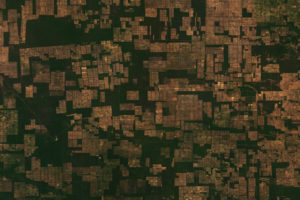
Expanding industrial agriculture—large-scale farms and livestock operations—disproportionately contributes to soil degradation, unsustainable water use, biodiversity loss, and waste production. It also contributes to climate change while doing little to help feed local people. Data from Global Forest Watch reveal that tropical deforestation accounts for 8% of the world’s annual CO2 emissions [32]. This means that if tropical deforestation were a country, it would be the world’s third largest greenhouse gas emitter, following China and the United States.
Climate-changing greenhouse gas emissions from the agricultural sector are roughly split between emissions from land clearing and emissions from food production practices [33]. About half of those production emissions come from ruminant livestock, namely cattle, sheep, and goats [33]. Producing beef, the most common of the ruminant meats, requires more than 20 times more land and creates more than 20 times more greenhouse gases per calorie of edible protein compared to plant proteins like beans or lentils [33]. These animals are major sources of methane pollution, a greenhouse gas roughly 30 times more potent than CO2 [30]. Likewise, manure management, soils, and nitrogen fertilizer used in industrial agriculture account for roughly two-thirds of nitrous oxide emissions, which carry nearly 300 times the warming potential of CO2 over a century [34].
Current farming methods can degrade soil more than 100 times faster than new soil is formed [35]. Overplowing and overgrazing turn fertile land into wasteland, which in turn increases both food insecurity and climate vulnerability, especially for the over 500 million people already living in areas that have recently experienced desertification [14]. Far more people live in populous arid regions where land degradation poses a risk to food production. As soils erode, the land loses its capacity to store climate-warming carbon.
Even as world food production has grown, so have the number of people experiencing chronic hunger—exceeding 700 million in 2023 [36]. Feeding the additional 2 billion people projected to be added to the planet by 2070 will require rebalancing food supply and demand [9]. As emerging economies continue to grow, so too will the demand for resource-intensive foods like animal products [37]. The demand for ruminant meat (beef, lamb, and goat) is projected to increase by 88% between 2010 and 2050, posing challenges to curbing greenhouse gas emissions and preventing the conversion of remaining forests to farmland [33]. In fact, analysis from the United Nations, the World Bank, and the World Resources Institute concludes that without major increases in agricultural productivity, the land area required to feed the world’s growing population could wipe out most of the world’s forests and woodlands by mid-century—further accelerating the impacts of climate change [33]. At the same time, changing climate and weather patterns make farming more challenging. Higher temperatures and prolonged droughts can easily lead to stress on farm animals and crop failures [38].
Feeding the additional 2 billion people projected to be added to the planet by 2050 will require rebalancing food supply and demand.
Combating Climate Change
Reducing the impacts of climate change and meeting the goals set forth by the Paris Agreement will require immediate and ambitious action to decarbonize economies, halt deforestation, restore ecosystems, and remove CO2 from the atmosphere [4, 39]. Wealthier industrial countries bear the greatest responsibility to cut emissions and help less affluent countries move onto a sustainable development path through financial and capacity-building assistance.
The Future Is Green
The global conversion to renewable energy is essential to addressing the world’s current climate crisis. That means shifting electricity production from fossil fuels to renewable sources, predominantly solar and wind. It also means electrifying transportation to reduce reliance on oil and ramping up energy efficiency across the board. Because fossil fuels represent the majority of global greenhouse gas emissions, the potential impact of shifting to renewable sources is substantial. This is especially important given projections for population growth and increased consumption levels in lower- and middle-income countries [40]. Scientists estimate that to avoid exceeding a 2oC rise in temperature, much of remaining fossil fuel reserves need to be left in the ground: over 80% of coal, half of natural gas, and one-third of oil [41].
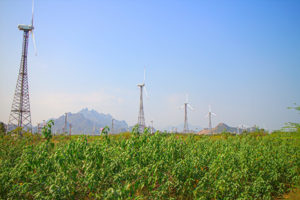
The good news is that though they are starting from a comparatively small base, solar and wind power are now the fastest growing sources of energy [20]. In a growing number of locations around the world, solar and wind are also the cheapest sources of electricity [42]. Between 2010 and 2022, the global average cost of electricity from wind farms fell by 69%, and from solar photovoltaics by a massive 89% [42]. In Australia, for example, government data revealed that solar power undercuts coal-generated electricity on cost, even if the coal itself were free [43]. In the United States, renewables have recently surpassed both coal and nuclear power as sources of energy [44]. Of the country’s 530 coal-fired power plants, 385 have recently closed or announced plans to retire [45].
Robust connected electric grids with solar, wind, and hydropower can balance fluctuations in renewable energy supply [46]. With the costs of batteries also falling quickly, the potential carbon emissions cuts in the energy sector grow [47]. Combining rooftop solar systems with storage batteries and electric vehicles make it possible to use sun-power around the clock and to swap out petroleum for driving. Germany illustrates this potential: in 2023 it doubled the number of batteries attached to solar PV systems to over 1 million units, which will help the country reach its goal to get 80% of its electricity from renewable sources [48].
For the nearly 745 million people in the world without access to electricity, off-grid rooftop solar systems are a winning option that can be installed quickly and relatively inexpensively [49]. For instance, in India, solar panels plus efficient light bulbs have proved cheaper than repeated purchases of kerosene for lanterns, and also are far less polluting [43]. The growing energy needs of low-income and emerging economies can be supplied more cleanly with a broader range of sustainable options than what was available to their industrialized predecessors. By incentivizing renewables, countries can contribute to combating global warming while still increasing GDP [50].
The Future Is Climate-Smart Food Production
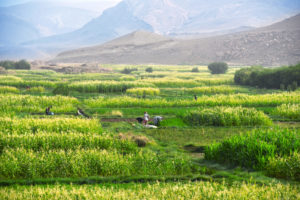
As energy efficiency has increased, so has agricultural efficiency. Over recent decades, farmers around the world have increased the amount of food they produce from a given parcel of land. Such yield gains moderate farming’s climate impact. In the United States, for example, grain and livestock output increased by roughly 50% over the last 30 years while farm-based greenhouse gas emissions rose by 6% [51, 52]. However, further innovations are paramount. The future of food security depends on the development of sustainable food systems that facilitate equitable production and consumption, reduce degradation, prevent biodiversity loss, and build resilience. Researchers maintain that the global agriculture sector must reduce emissions by two-thirds or more by 2050 against 2010 levels in order to avoid dangerous climate change [33]. This target includes ceasing the conversion of forests to agriculture and actively reforesting large areas of land around the world. Additional increases in crop yields will be necessary to achieve that goal while reducing hunger.
Climate Smart Agriculture (CSA) is described by the World Bank as an “integrated approach to managing landscapes—cropland, livestock, forests, and fisheries—that addresses the interlinked challenges of food security and climate change” [53]. The goals of CSA are to simultaneously increase farm productivity and climate resilience while reducing emissions [54]. A number of CSA programs have already made impressive improvements around the world. For example, a World Bank project expanding water use efficiency and soil quality in China helped more than 29,000 farmers improve income levels and climate resilience [53]. In Africa’s Sahel region, an FAO-supported agro-forestry program helped to restore productivity to 12,000 hectares of degraded land in Burkina Faso and Niger [55].
The goals of CSA are to simultaneously increase productivity and climate resilience while reducing emissions.
The Future Is Conscious Consumption
Beyond improving land management, creating a sustainable food future involves major economic and cultural shifts, including reigning in food waste and transitioning diets that are heavy in meat towards more plant-based foods [33]. Currently about one-third of the food raised or prepared is not eaten [56]. Food waste is to blame for roughly 10% of global greenhouse gas emissions [14, 57, 58]. A variety of interventions from the farm to the consumer—ranging from improvements in infrastructure for storage, processing, and transportation in food supply chains to the establishment of national food-waste targets and policies that discourage wasteful consumption—can help ensure that more food makes it to dinner tables [59].
Additionally, the fact that raising livestock for meat, milk, and eggs generates substantial greenhouse gas emissions and is among the leading causes of deforestation, biodiversity loss, and water pollution signals the potential environmental benefits of limiting the consumption of animal products (see Figure 6) [60-63]. For example, if each person chose to limit their beef consumption to an average of 1,560 calories a month (about six hamburgers worth), far less land would be needed to raise cattle and grow their feed, taking the world about halfway to meeting 2050 goals for agricultural emissions cuts, according to the World Resource Institute [64].
Figure 6
Some of the most effective interventions to reduce future food demand and thus agriculture-related greenhouse gas emissions will be those that facilitate slower population growth. This is especially true for the regions in which population growth is expected to occur the fastest. Stabilizing population involves increasing educational opportunities for girls, expanding access to high quality reproductive health services, and reducing infant and child mortality rates through improved health services [33].
The Future Is Forests
Growing plants and trees pull carbon from the atmosphere. Forest protection, tree planting, and ecosystem restoration are therefore critical to limiting climate change. Recent estimates project that letting saplings regrow and mature on land where forests have been cleared could increase global forested area by one-sixth and remove on the order of 200 billion metric tons of carbon from the atmosphere [65]. Pervasive ecological restoration could sequester a good share of the 300 billion metric tons of carbon that have accumulated in the atmosphere from a century of human emissions [65-67].
Forest restoration is integral for maintaining biodiversity and averting species extinction. It also provides a variety of social and economic benefits. Many conservation efforts are focused on the world’s highly biodiverse tropical forests, only half of which remain standing [68]. A team of researchers from Brazil, the United States, and Europe identified more than 100 million hectares throughout Central and South America, Africa, and Southeast Asia where forest restoration would be most cost-effective and feasible, providing climate mitigation and adaptation benefits, improvements to water security, and other positive outcomes [68]. Six sub-Saharan African countries—Rwanda, Uganda, Burundi, Togo, South Sudan, and Madagascar—had the highest potential for low-cost and high-benefit forest restoration. Reforestation efforts in these countries, home to some of the fastest growing populations in the world, could cost-effectively provide a range of benefits to local people while mitigating climate change and improving climate adaptation capacity [9].
Overall, replanting degraded lands, reforesting ecological landscapes, and stopping tree clearing could reduce emissions and increase nature’s carbon storage capacity. This would also benefit biodiversity and enhance ecological services, such as air and water purification, soil stabilization, and storm buffering, all of which will become more important in a warmer world.
Conclusions
Understanding the links between population and the environment is critical to combating climate change. Human impacts on the environment are compounded by population growth and growing affluence. Global population pressures can strain the availability and equitable allocation of natural resources. Increasing demand for food and energy generally results in higher total emissions, although as more efficient practices are adopted, increasing demand may have less of an impact on emissions going forward. The future trajectory of production practices and consumption patterns will determine the scope and severity of climate change, the effects of which will be most devastating for the world’s most marginalized people. Ultimately, the countries and corporations most responsible for global emissions are most responsible for mitigating climate change.
As the world’s population continues to grow, so too will the demand for finite resources. The environmental implications of slowing population growth through measures like voluntary family planning and education are compelling. Project Drawdown argues that meeting the global unmet need for contraceptives, together with increasing access to education for women and girls, could result in emissions reductions of 69 gigatons of CO2 equivalent by 2050 [59]. This is comparable to permanently closing some 18,000 coal-fired power plants [69].
Voluntary reductions in fertility are amplified across generations. For example, if the whole world adopted fertility rates just higher than those seen in Germany, Japan, Spain, Portugal, or Italy, the population would shrink to 4 billion by 2100, as opposed to the 10.2 billion currently projected by the United Nations Population Division [9, 70]. For reference, the last time our global population was 4 billion people was in 1975, when concerns about humanity’s capacity to sustainably live, produce food, and consume resources on a planet of dwindling finite resources were already widespread. Now, almost 50 years later, our population has doubled but our planet and its resources remain finite. Given the stresses on the Earth’s natural systems, the prospects for feeding a smaller population are far more promising than a larger one. Reducing fertility rates through rights-based development strategies such as voluntary family planning services and girls’ education has the potential to yield myriad social and environmental benefits—among them increased climate resilience and adaptive capacity, especially for the world’s most vulnerable populations, as well as a significant reduction in global greenhouse gas emissions over the long term.
Ultimately, curbing human impacts on the environment and slowing climate change involves shifting the global economy in favor of renewable energy sources, reshaping food production and consumption patterns, ending deforestation, and protecting and rehabilitating ecosystems. Slowing population growth is an important tool in tackling these challenges.
Updated October 2024
ENDNOTES
- Díaz, S., et al., Summary for policymakers of the global assessment report on biodiversity and ecosystem services of the Intergovernmental Science-Policy Platform on Biodiversity and Ecosystem Services. 2019.
- Steffen, W., et al., Planetary boundaries: Guiding human development on a changing planet. Science, 2015. 347(6223): p. 1259855.
- Carey, B., Climate change on pace to occur 10 times faster than any change recorded in past 65 million years. Stanford Report, 2013.
- WMO, et al., United in science: High-level synthesis report of latest climate science information convened by the Science Advisory Group of the UN Climate Action Summit 2019. 2019: https://wedocs.unep.org/bitstream/handle/20.500.11822/30023/climsci.pdf.
- Costanza, R., et al., Changes in the global value of ecosystem services. Global environmental change, 2014. 26: p. 152-158.
- Global Footprint Network. Ecological footprint. 2020; Available from: https://www.footprintnetwork.org/our-work/ecological-footprint.
- Lin, D. and M. Wackernagel. Estimating the date of Earth Overshoot Day 2024. 2024; Available from: https://overshoot.footprintnetwork.org/content/uploads/2024/06/2024-Nowcast-explained.pdf.
- IPCC, Summary for policymakers. In: Climate Change 2023: Synthesis Report. Contribution of Working Groups I, II and III to the Sixth Assessment Report of the Intergovernmental Panel on Climate Change, Core Writing Team, H. Lee, and J. Romero, Editors. 2023: https://www.ipcc.ch/report/ar6/syr/.
- United Nations. World population prospects database. 2024; Available from: https://population.un.org/wpp.
- IPCC, Summary for policymakers. In: Global Warming of 1.5°C. An IPCC Special Report on the impacts of global warming of 1.5°C above pre-industrial levels and related global greenhouse gas emission pathways, in the context of strengthening the global response to the threat of climate change, sustainable development, and efforts to eradicate poverty, V. Masson-Delmotte, P. Zhai, H.-O. Pörtner, D. Roberts, J. Skea, P.R. Shukla, A. Pirani, W. Moufouma-Okia, C. Péan, R. Pidcock, S. Connors, J.B.R. Matthews, Y. Chen, X. Zhou, M.I. Gomis, E. Lonnoy, T. Maycock, M. Tignor, and T. Waterfield, Editor. 2018: https://www.ipcc.ch/sr15/chapter/spm/.
- United Nations. Paris Agreement. 2015; Available from: https://unfccc.int/files/essential_background/convention/application/pdf/english_paris_agreement.pdf.
- UNEP, Emissions gap report 2023: Broken record – Temperatures hit new highs, yet world fails to cut emissions (again). 2023, United Nations Environment Programme: https://www.unep.org/resources/emissions-gap-report-2023.
- Crippa, M., et al., GHG emissions of all world countries. 2023, Publications Office of the European Union: Luxembourg.
- Shukla, P., et al., Climate change and land: An IPCC special report on climate change, desertification, land degradation, sustainable land management, food security, and greenhouse gas fluxes in terrestrial ecosystems. Technical summary. 2020, IPCC: https://www.ipcc.ch/srccl/.
- IPCC, Summary for policymakers, in Climate Change 2014: Impacts, Adaptation, and Vulnerability. Part A: Global and Sectoral Aspects. Contribution of Working Group II to the Fifth Assessment Report of the Intergovernmental Panel on Climate Change. 2014, Cambridge University Press: Cambridge, U.K., and New York.
- Ritchie, H., P. Rosado, and M. Roser. CO₂ and greenhouse gas emissions. Our World in Data 2024; Available from: https://ourworldindata.org/co2-and-other-greenhouse-gas-emissions.
- Global Carbon Project. Annual CO₂ emissions by world region. CO₂ and Greenhouse Gas Emissions 2023; Available from: https://ourworldindata.org/grapher/annual-co-emissions-by-region.
- Le Quéré, C., et al., Drivers of declining CO2 emissions in 18 developed economies. Nature Climate Change, 2019. 9(3): p. 213-217.
- World Bank. World Bank open data. 2024; Available from: https://data.worldbank.org/.
- Energy Institute. Statistical Review of World Energy data. 2024; Available from: https://www.energyinst.org/statistical-review/home.
- Steinberger, J.K., et al., Pathways of human development and carbon emissions embodied in trade. Nature Climate Change, 2012. 2(2): p. 81-85.
- Moran, D., A. Hasanbeigi, and C. Springer, The carbon loophole in climate policy, in Quantifying the Embodied Carbon in Traded Products. 2018, KGM & Associates Pty Ltd., Global Efficiency Intelligence, LLC, ClimateWorks Foundation: https://buyclean.org/media/2016/12/The-Carbon-Loophole-in-Climate-Policy-Final.pdf.
- World Bank. The World Bank in Middle Income Countries. 2024; Available from: https://www.worldbank.org/en/country/mic.
- Mogelgaard, K. and K.P. Patterson, Building resilience through family planning and adaptation finance, in Population Reference Bureau Policy Brief. 2018, Population Reference Bureau: Washington, DC.
- World Resources Institute, Climate Watch. 2024: https://www.climatewatchdata.org/ghg-emissions.
- InfluenceMap. The Carbon Majors database: Launch report. 2024; Available from: https://carbonmajors.org/briefing/The-Carbon-Majors-Database-26913.
- InfluenceMap. Carbon Majors website and database. 2024; Available from: https://carbonmajors.org.
- Schleussner, C.F., et al., Carbon majors’ trillion dollar damages. 2023, Climate Analytics.
- FAO, State of the world’s forests 2024. 2024, U.N. Food and Agriculture Organization: Rome.
- IPCC, Climate change 2014: Synthesis report. Contribution of Working Groups I, II and III to the Fifth Assessment Report of the Intergovernmental Panel on Climate Change. 2015, Geneva: Intergovernmental Panel on Climate Change.
- World Resources Institute. Forest loss. Indicators of forest extent 2024; Available from: https://research.wri.org/gfr/forest-extent-indicators/forest-loss.
- Gibbs, D., N. Harris, and F. Seymour, By the numbers: the value of tropical forests in the climate change equation, in World Resources Institute. 2018.
- Searchinger, T., et al., Creating a sustainable food future: A menu of solutions to feed nearly 10 billion people by 2050. Final report. 2019, World Resources Institute, the World Bank Group, the United Nations Environment Programme, the United Nations Development Programme, the Centre de coopération internationale en recherche agronomique pour le développement, and the Institut national de la recherche agronomique: Washington, DC.
- Butterbach-Bahl, K., et al., Nitrous oxide emissions from soils: How well do we understand the processes and their controls? Philosophical Transactions of the Royal Society B: Biological Sciences, 2013. 368(1621): p. 20130122.
- IPCC, Summary for policymakers. In: Climate Change and Land: An IPCC special report on climate change, desertification, land degradation, sustainable land management, food security, and greenhouse gas fluxes in terrestrial ecosystems, P.R. Shukla, et al., Editors. 2019: https://www.ipcc.ch/srccl/chapter/summary-for-policymakers.
- FAO, et al., The state of food security and nutrition in the world 2024: Financing to end hunger, food insecurity and malnutrition in all its forms. 2024, FAO, IFAD, UNICEF, WFP, and WHO: Rome.
- IFPRI, 2024 Global food policy report: Food systems for healthy diets and nutrition. 2024, International Food Policy Research Institute: Washington, DC.
- FAO, The future of food and agriculture – Drivers and triggers for transformation. 2022, U.N. Food and Agriculture Organization: Rome.
- UNFCCC. The Paris Agreement. 2020; Available from: https://unfccc.int/process-and-meetings/the-paris-agreement/the-paris-agreement.
- United Nations, World population prospects 2024: Summary of results. 2024, UN Department of Economic and Social Affairs, Population Division.
- McGlade, C. and P. Ekins, The geographical distribution of fossil fuels unused when limiting global warming to 2°C. Nature, 2015. 517(7533): p. 187-190.
- IRENA, Renewable power generation costs in 2022. 2023, International Renewable Energy Agency: Abu Dhabi.
- Brown, L.R., et al., The great transition: Shifting from fossil fuels to solar and wind energy. 2015, New York: WW Norton & Company.
- Francis, M. and O. Comstock. How has energy use changed throughout U.S. history? Today in energy 2024; Available from: https://www.eia.gov/todayinenergy/detail.php?id=62444.
- Sierra Club. Beyond coal. 2024; Available from: https://coal.sierraclub.org.
- Jacobson, M.Z., et al., 100% clean and renewable wind, water, and sunlight all-sector energy roadmaps for 139 countries of the world. Joule, 2017. 1(1): p. 108-121.
- Walter, D., et al., X-Change: Batteries—The battery domino effect. 2023, RMI: Colorado.
- Amelang, S. Number of solar batteries doubles to over one million in Germany in 2023. 2024; Available from: https://www.cleanenergywire.org/news/number-solar-batteries-doubles-over-one-million-germany-2023.
- REN21 Secretariat, Renewables 2024 global status report. 2024: https://www.ren21.net/reports/global-status-report/.
- Bilgili, F., E. Koçak, and Ü. Bulut, The dynamic impact of renewable energy consumption on CO2 emissions: A revisited Environmental Kuznets Curve approach. Renewable and Sustainable Energy Reviews, 2016. 54: p. 838-845.
- FAO, FAO-Stat. 2024, U.N. Food and Agriculture Organization: https://www.fao.org/faostat/en/#data.
- EPA, Greenhouse gas inventory data explorer. 2023, U.S. Environmental Protection Agency: https://cfpub.epa.gov/ghgdata/inventoryexplorer.
- World Bank. Climate-smart agriculture. 2019; Available from: https://www.worldbank.org/en/topic/climate-smart-agriculture.
- Lipper, L., et al., Climate-smart agriculture for food security. Nature Climate Change, 2014. 4(12): p. 1068-1072.
- FAO. Being climate-smart in agriculture. 2020; Available from: https://www.fao.org/climate-smart-agriculture.
- Project Drawdown, The drawdown review: Climate solutions for a new decade, K. Wilkinson, Editor. 2020.
- Zhu, J., et al., Cradle-to-grave emissions from food loss and waste represent half of total greenhouse gas emissions from food systems. Nature Food, 2023. 4(3): p. 247-256.
- Padmanaban, D. How wasted food turns into huge amounts of greenhouse gas. Scientific American 2023; Available from: https://www.scientificamerican.com/article/how-wasted-food-turns-into-huge-amounts-of-greenhouse-gas.
- Project Drawdown. Drawdown solutions library. 2024; Available from: https://drawdown.org/solutions.
- Gerber, P.J., et al., Tackling climate change through livestock: A global assessment of emissions and mitigation opportunities. 2013, Rome: U.N. Food and Agriculture Organization (FAO).
- Poore, J. and T. Nemecek, Reducing food’s environmental impacts through producers and consumers. Science, 2018. 360(6392): p. 987-992.
- Ritchie, H. You want to reduce the carbon footprint of your food? Focus on what you eat, not whether your food is local. Our World in Data 2020; Available from: https://ourworldindata.org/food-choice-vs-eating-local.
- Neufeld, D. The carbon footprint of the food supply chain. 2020; Available from: https://www.visualcapitalist.com/visualising-the-greenhouse-gas-impact-of-each-food.
- Ranganathan, J., et al., How to sustainably feed 10 billion people by 2050, in 21 charts. 2018, World Research Institute: https://www.wri.org/blog/2018/12/how-sustainably-feed-10-billion-people-2050-21-charts.
- Bastin, J.-F., et al., The global tree restoration potential. Science, 2019. 365(6448): p. 76-79.
- Bastin, J.-F., et al., Response to comments on “The global tree restoration potential”. Science, 2019. 366(6463): p. eaay8108.
- Chazdon, R. and P. Brancalion, Restoring forests as a means to many ends. Science, 2019. 365(6448): p. 24-25.
- Brancalion, P.H., et al., Global restoration opportunities in tropical rainforest landscapes. Science Advances, 2019. 5(7): p. eaav3223.
- Calma, J., Birth control and books can slow down climate change, in The Verge. 2020.
- Wackernagel, M., Shifting the population debate: Ending overshoot, by design & not disaster, in The Population Dimension. 2020, Global Footprint Network.

